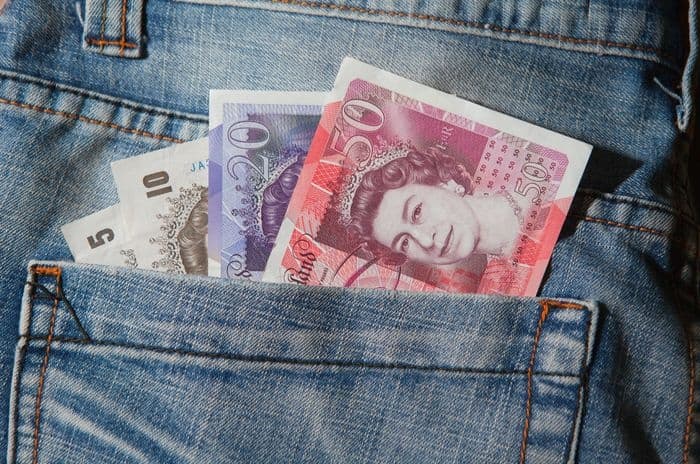LONGER lasting and more secure banknotes are being introduced by both the Bank of England and the Bank of Scotland.

Credit: Barabas Csaba/Shutterstock.com
Hard to damage and difficult to fake, polymer banknotes are already used in many countries throughout the world. Now they're coming to the UK.
The first circulation will be in Scotland and limited to just fifty £5 notes specially designed by children and issued in November 2015. The notes will be auctioned off to raise money for BBC Children in Need.
The main quantity of £5 polymer notes will be issued throughout Scotland late in the second half of 2016 with £10 notes coming into circulation the following year. There will be a similar time table for England too.
Paper money has had its day
There have been fantastic advances in the way people make transactions, with contactless cards, online commerce and mobile banking. There is even a new kind of digital currency, bitcoins that only exists electronically.
Yet there seems to be little innovation in the actual cash that most people still use in their day to day lives.
Now it's been announced the UK's next £5 and £10 banknotes will be printed on a flexible plastic film called polymer.
This new material offers many advantages over the existing cotton paper used for notes currently in circulation.
It's resistant to dirt and moisture so it will stay cleaner longer than paper. Polymer won't be destroyed by a spin in a washing machine but will melt under extreme heat, so they won't survive if someone accidentally leaves them under an iron.
The notes can be easily folded and are just as easy to slip into a purse or wallet as paper money. And although they feel slippery when new, this tends to decline over time, once the notes have been in circulation for a while.
The new banknotes are durable too, predicted to last over twice as long as their paper alternatives. Less need for reprinting means they are more environmentally friendly and cheaper to produce.
Perhaps their most important feature is that they're more secure than the existing currency. Advanced security features make polymer notes almost impossible to counterfeit.
Polymer notes are taking over
It's not the first time that polymer notes will have been used in the world. They were first introduced as far back as 1988 in Mexico, Singapore, Canada and Australia. And now 20 countries have adopted them.
Indeed it's not even the first time polymer notes have been used in Scotland.
The Clydesdale Bank, one of three in Scotland authorised to issue banknotes, gave out a limited edition of polymer notes from its branches of the Clydesdale in March 2015 to commemorate the Forth's Bridge 125th anniversary.
Sir William Arrol, whose company constructed the bridge and many other landmarks in Scotland, features on the notes.
Soon polymer notes will be spent all over the UK.
Before the decision to switch was made a research team commissioned by the Bank of England visited various shopping centres around the UK to gauge public opinion.
Nearly 13,000 people gave feedback. The Bank said 87% of those who responded were in favour of polymer and only 6% were opposed with 7% neutral.
Despite the many advantages the new note brings, getting it into circulation is not without problems [pdf].
It's always difficult when introducing a radically new note or coin into circulation to educate businesses, retailers and the public to accept it. So the Bank will launch a massive educational programme to ensure everyone knows what the new notes look like and how to authenticate them.
They'll also have to work closely with "hole in the wall" and vendor machines to make sure that notes can easily be accepted and dispensed.
Initially £5 and £10 paper notes will be replaced by polymer ones in a gradual process. A decision on whether to print £20 and £50 in polymer will then be made at a later date.
So soon the whole country will be enjoying the benefit of more durable banknotes.
Existing notes are good enough for now
In the meantime does that mean people will have to put up with inferior notes?
Fortunately even our existing paper money is surprisingly robust. And if a note is torn in half or significantly damaged they can be replaced.
Fake or real? How to spot a genuine bank note.
It's important to check for more than one security feature.
- Check the feel of the paper and the raised print across the words "Bank of England"
- Hold up to the light to check the watermark. An image of the Queen should be visible in the clear oval area in the middle of the note
- Look for the metallic thread running through the note. It should appear as a continuous straight line.
You'll also find more detailed information on the Bank of England booklet "take a closer look"
Understandably banks are eager not to pay out more than once on the same note. So as a general rule there should be physical evidence of at least half a note before recompense is considered. But even if there's not banks will take into account evidence of how the note was damaged.
People can either write to the Bank of England for a new note although it's much more convenient simply to pop into a local bank.
It's not such good news for anyone finding a counterfeit note in their purse or wallet. It's totally worthless. Even worse if they innocently try to spend it and a retailer spots its fake they are within their rights to confiscate it and pass it on to the police.
However it's still difficult to forge paper currency in the UK. There are also tips on the Bank of England website to spot a forgery including a banknote virtual tour.
But when polymer replaces paper notes perhaps they won't be needed.








